


 |
 |
 |
|
|
Navigation LakesnWoods.com
© 2004-2025 DCMA, Defamation, Copyright and Trademark Infingement Policy
|
|
||||||||||||||||||||||||||||||||||||||||||||||||||||||||||||||||||||||||||||||||||||||||||||||||||||||||||||||||||||||||||||||||||||||||||||||||||||||||||||||||||||||||||||||||||||||||||||||||||||||||||||||||||||||||||||
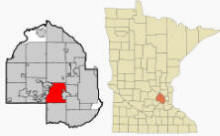 |
| Minnetonka (city) | 1970 | 1980 | 1990 | 2000 | 2007 (est) |
1990-2000 Change | |
|---|---|---|---|---|---|---|---|
| Actual | Percent | ||||||
| Population | 35,776 | 38,683 | 48,370 | 51,301 | 51,499 | 2,931 | 6.06 |
| Land Area (sq. mile) | 26.90 | 27.71 | 27.10 | 27.14 | -- | 0.04 | 0.16 |
| Density (persons per sq. mile) | 1,330.0 | 1,396.0 | 1,784.9 | 1,890.0 | -- | 105.16 | 5.89 |
| Housing Units | 9,270 | 13,231 | 20,119 | 22,228 | -- | 2,109 | 10.48 |
| Households | -- | 12,667 | 18,687 | 21,393 | 22,092 | 2,706 | 14.48 |
| Persons Per Household | -- | 3.00 | 2.56 | 2.37 | 2.29 | -0.19 | -7.27 |
Minnetonka is a suburban city in Hennepin County, Minnesota, eight miles (13 km) west of Minneapolis. Part of the city includes the Eastern tip of Lake Minnetonka, one of the largest lakes in Minnesota. The outlet of Lake Minnetonka is Minnehaha Creek, which winds through South Minneapolis before ending at Minnehaha Falls and flowing into the Mississippi River. Interstates 394 and 494 are two of the main routes in the city. According to the United States Census Bureau, the city has a total area of 28.2 square miles (73.1 km˛)—27.1 square miles (70.3 km˛) of it is land and 1.1 square miles (2.87 km˛) of it (3.83%) is water. The elevation is 889 ft (271 m) above sea level.
From Wikipedia, the free encyclopedia.
There were 21,393 households out of which 29.1% had children under the age of 18 living with them, 56.6% were married couples living together, 6.8% had a female householder with no husband present, and 34.1% were non-families. 27.3% of all households are made up of single individuals and 9.3% had someone living alone who was 65 years of age or older. The average household size was 2.37 and the average family size was 2.92.
In the city the population was spread out with 23.1% under the age of 18, 6.0% from 18 to 24, 28.5% from 25 to 44, 28.4% from 45 to 64, and 14.0% who were 65 years of age or older. The median age was 41 years. For every 100 females there were 91.8 males. For every 100 females age 18 and over, there were 88.7 males.
According to a 2007 estimate, the median income for a household in the city was $78,840, and the median income for a family was $101,793. Males had a median income of $57,439 versus $38,605 for females. The per capita income for the city was $40,410. About 1.5% of families and 2.6% of the population were below the poverty line, including 2.3% of those under age 18 and 4.1% of those age 65 or over.
Visit The
Minnesota History Shop!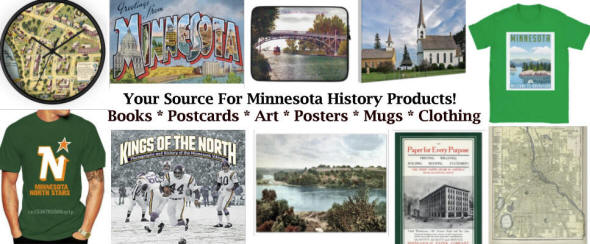 |
Since the mid-1800s Minnetonka has evolved from heavily wooded wilderness through extensive farming and thriving industrialization to its present primarily residential suburban character. The Dakota and Ojibway Indians were the first people to settle in the area. They believed the land around Lake Minnetonka (minne meaning water and tonka meaning big) was the legendary home of an extinct race. The first recorded exploration of the area by European settlers was in 1822, when a group from newly constructed Fort Snelling made its way up Minnehaha Creek (then known as Brown's Creek or Falls Creek) to the lake. In 1851 the Dakotah sold the area including Minnetonka to the United States with the Treaty of Traverse des Sioux. The first census, the Territorial Census of 1857, lists 41 households. Twenty-nine of the heads of households are listed as farmers. The occupations of the remaining twelve are associated with the operations of Minnetonka Mill and a nearby hotel.
In 1852 a claim was staked on Minnehaha Creek near
McGinty Road. The sawmill that was constructed in the thick woods of
maple, oak, elm, red cedar and basswood was the first privately-operated
mill in Minnesota west of the Mississippi River. Oak timbers from this
mill were used to build the first suspension bridge across the
Mississippi River at St. Anthony Falls in 1853. The settlement of
Minnetonka Mills that grew up around the mill was the first permanent
European-American settlement west of Minneapolis in Hennepin County. In
1855 a two-story sawmill was constructed with a furniture factory on the
second floor. A building for varnishing furniture was built on the south
side of the creek, at the present Bridge Street. Production consisted
mainly of chairs and bedsteads. The Minnetonka Republican at St. Anthony
published a short article describing the area. The February 12, 1857
issue said:
“ Minnetonka City - We have already called attention to the thrift and
activity of that little town. Large investments are made there. On
January 1, 40 hands were being employed turning out weekly 500 chairs
and 200 bedsteads. By April it will be 2000 weekly. One million feet of
lumber is in the pond, half of it nicely seasoned. Machinery is on the
way for a flour mill. J. P. Miller is erecting a new hotel. ”
But competition from the mills at St. Anthony, the drowning of the mill's manager in 1857 and a fire in 1860 dashed the lofty hopes. From 1860 to 1869 the mill area had no active mill. In 1869, Thomas Perkins constructed a 3˝ story flour mill and an ad joining cooper shop. At the peak of its production, around 1880, the mill ground about 400 barrels of flour daily and employed 18 men. One of its brands, "Snow Ball," was priced at $3.00 per hundred pound, and local farmers were paid $1.00 per bushel of wheat. From 1874 to the mid-1880s, Charles Burwell managed the Minnetonka Mill Company's operations.
Milling played a major role in the development of Minnetonka and Minnehaha Creek provided power to operate these mills. Most of the earliest settlers were from New England and other eastern and central states, with Irish people settling in northern Minnetonka later. In the 1860s Scandinavians came where the climate and terrain reminded them of their native land. Immigrants from Czechoslovakia settled in the southern part of Minnetonka from 1854 to 1871. They contributed greatly to the professional, business and agricultural segments of the population. The raspberries they grew in Minnetonka for sale in Hopkins prompted Hopkins to call itself "The Raspberry Capital of the World." The Cargill Lake Office, occupying a former mansion, houses the company's top executives.
In 1860, after only 8 years of operation, the sawmill closed. In 1869 a flour and grist mill were constructed and operated until the late 1880s. In 1874 Charles H. Burwell came to manage the Minnetonka Mill Company, and he built a Victorian home on the north bank of Minnehaha Creek (Minnetonka Boulevard at McGinty Road East) for his family. The Charles H. Burwell House is now on the National Register of Historic Places and is owned by the city. There were two other mills in Minnetonka. The St. Alban's Mill, which was less than a mile downstream from Minnetonka Mills on Minnehaha Creek, operated as a flour mill from 1874 to 1881. A grist mill built on Purgatory Creek was washed out in a flood shortly after construction. Minnetonka Mills, with its post office and port for Lake Minnetonka, was the principal business and trading center for a large area until the 1870s.
Between 1883 and 1956 the area within the original 36-square-mile (93 km2) township grew smaller as Wayzata, Hopkins, Deephaven, Woodland and St. Louis Park incorporated or annexed portions of Minnetonka. Excellent transportation facilities to Hopkins and Minneapolis began to transform Minnetonka township's economy. Train service to Minneapolis had been available since the 1880s and in 1905 streetcar service began. The attraction to become a city wage earner was great and rapid transit made it possible. In 1956, as a maneuver to prevent neighboring villages from continuing to annex portions of Minnetonka township, residents in 1956 voted to establish a village out of the remaining twenty-eight square miles and the area was incorporated as Minnetonka Village. However, Minnetonka Village lasted only thirteen years. The complexities and the heavy demands of administering a rapidly developing community required professional management and larger representation. In 1969 a city charter was approved to serve the 35,000 residents.
From Wikipedia, the free encyclopedia
Twenty years later, in 1843, Joseph N. Nicollet's map and report of this region, based on preceding maps and filled out by much information from his own explorations and from Indians and white voyageurs whom he questioned, had no intimation of the existence of Minnetonka. It seems to have been entirely forgotten by the officers of the fort with whom Nicollet was intimately acquainted. Because it was in the Dakota country, not ceded for white immigration until the treaties of Traverse des Sioux and Mendota in 1851, ratified by Congress the next year, this fairest one of our myriad lakes remained to be named and published when its first white settlers came.
In the chapter on this township,
contributed by Judge Henry G. Hicks to the history of the county in
1895, the exploration of the lower part of this lake by Simon Stevens
and Calvin A. Tuttle in April 1852 is well narrated. Two days after
their return, the St. Anthony Express for April 16 published an
article titled "
The present more felicitous name was
coined about six weeks later by Gov. Ramsey, when, near the end of May,
he made a journey to this lake in a company of several prominent
citizens from St. Anthony and St. Paul. An article by Goodhue in his
newspaper, the Minnesota Pioneer, for July 1, says: "The lake was
named by
Minne (also spelled mini)
is the common
Courtesy Minnesota Historical Society
|
Minnetonka City Hall 14600 Minnetonka Blvd. Minnetonka, MN 55345 Phone: (952) 939-8200 Fax: (952) 939-8244 Regular Business Hours: Monday–Friday 8:00 am–4:30 pm City Council Meetings Mondays at 6:30 pm 





 |
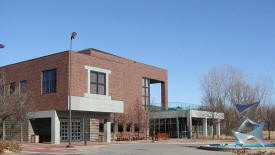 |
|||
| Title | Term Ends | Name and Address | Phone | |
| Mayor | 12/31/2021 |
Brad Wiersum 15920 Portico Drive Minnetonka, MN 55345 |
 |
(612) 723-3907 |
| City Manager | appointed | Geralyn Barone 14600 Minnetonka Blvd. Minnetonka, MN 55345 |
 |
(952) 939-8200 |
| Council Member At Large |
12/31/2021 |
Deb Calvert 3814 Baker Road Minnetonka, MN 55345 |
  |
(612) 205-5399 |
| Council Member At Large |
12/31/2021 |
Susan Carter 3416 Fairlawn Drive Minnetonka, MN 55345 |
  |
(952) 381-4477 |
| Council Member Ward 1 |
12/31/2023 |
Brian J. Kirk 4916 Carleton Road Minnetonka, MN 55345 |
  |
(952) 451-6251 |
| Council Member Ward 2 |
12/31/2023 |
Rebecca Schack 3201 Plymouth Road Minnetonka, MN 55305 |
  |
(612) 590-3735 |
| Council Member Ward 3 |
12/31/2023 |
Bradley Schaeppi 315 Townes Lane Minnetonka, MN 55345 |
 |
(612) 770-7447 |
| Council Member Ward 4 |
12/31/2023 |
Kissy C. Coakley 16417 Hilltop Terrace Minnetonka, MN 55345 |
  |
(952) 486-9670 |
|
US Post Office 14702 Excelsior Blvd. Minnetonka, MN 55345-6606 Phone: (952) 935-4909 Toll Free: (800) ASK-USPS   |
|
||
|
|||
| Utility Type | Utility Name | Utility Phone |
| Electricity | Xcel Energy | (800) 895-4999 |
| Natural Gas | Centerpoint Energy | (612) 372-4664 |
| Wastewater | Metropolitan Council | (612) 222-8423 |
| Water | City of Minnetonka | n/a |
| Telephone | CenturyLink Communications | (800) 603-6000 |
| Cable TV | Comcast | (800) 266-2278 |
| Employer | Products/Services | Employees |
| Cargill | Support Activities for Crop Production | 3,400 |
| Carlson Companies Inc | Travel Agencies | 3,100 |
| St. Jude Medical | Surgical & Medical Instrument Mfg. | 1,300 |
| Allina Health System | Insurance Carriers | 1,200 |
| DataCard Corp | Office Supplies & Stationery Stores | 1,000 |
| Advantek Inc | Semiconductor & Other Electronic Component Mfg. | 600 |
| Osmonics Inc | Water Supply & Irrigation Systems | 520 |
| American Medical Systems | Scientific Research & Development Services | 500 |
| Opportunity Partners | Vocational Rehabilitation Svcs. | 500 |
| Scicom Data Service | Data Processing, Hosting, & Related Svcs. | 195 |
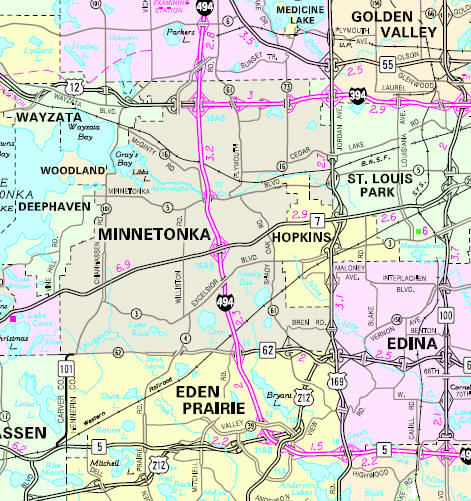
Minnesota State
Highway Map of the Minnetonka Minnesota area
Check Out
The Minnesota
History Shop! Good Goods and
Great Gifts!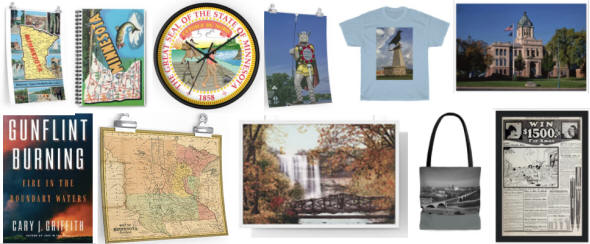 |
| Local | |
| Metro | |
|
see the Twin Cities Media Guide page for Twin Cities metro area newspapers, radio and TV |
|
|
|
|
|
|
|
© 2004-2025 LakesnWoods LLC All Rights Reserved |
|
|
|
||